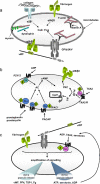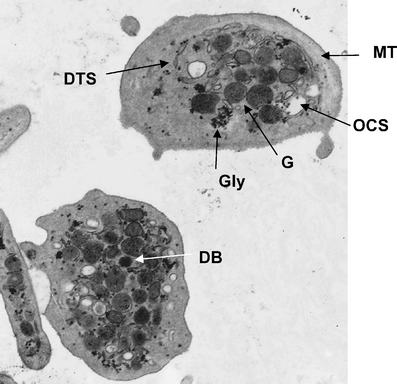What's new in using platelet research? To unravel thrombopathies and other human disorders
- PMID: 17619901
- PMCID: PMC2042511
- DOI: 10.1007/s00431-007-0543-7
What's new in using platelet research? To unravel thrombopathies and other human disorders
Abstract
This review on platelet research focuses on defects of adhesion, cytoskeletal organisation, signal transduction and secretion. Platelet defects can be studied by different laboratory platelet functional assays and morphological studies. Easy bruising or a suspected platelet-based bleeding disorder is of course the most obvious reason to test the platelet function in a patient. However, nowadays platelet research also contributes to our understanding of human pathology in other disciplines such as neurology, nephrology, endocrinology and metabolic diseases. Apart from a discussion on classical thrombopathies, this review will also deal with the less commonly known relation between platelet research and disorders with a broader clinical phenotype. Classical thrombopathies involve disorders of platelet adhesion such as Glanzmann thrombastenia and Bernard-Soulier syndrome, defective G protein signalling diseases with impaired phospholipase C activation, and abnormal platelet granule secretion disorders such as gray platelet disorder and delta-storage pool disease. Other clinical symptoms besides a bleeding tendency have been described in MYH9-related disorders and Duchenne muscular dystrophy due to adhesion defects, and also in disorders of impaired Gs signalling, in Hermansky Pudlack disease and Chediak Higashi disease with abnormal secretion. Finally, platelet research can also be used to unravel novel mechanisms involved in many neurological disorders such as depression and autism with only a subclinical platelet defect.
Figures


Similar articles
-
Inherited traits affecting platelet function.Blood Rev. 2008 May;22(3):155-72. doi: 10.1016/j.blre.2007.11.002. Epub 2008 Jan 3. Blood Rev. 2008. PMID: 18180086 Review.
-
Membrane defects in inherited disorders of platelet function.Am J Pediatr Hematol Oncol. 1982 Spring;4(1):83-94. Am J Pediatr Hematol Oncol. 1982. PMID: 7091581
-
The level of laboratory testing required for diagnosis or exclusion of a platelet function disorder using platelet aggregation and secretion assays.Semin Thromb Hemost. 2009 Mar;35(2):242-54. doi: 10.1055/s-0029-1220785. Epub 2009 Apr 30. Semin Thromb Hemost. 2009. PMID: 19408197 Review.
-
Congenital disorders associated with platelet dysfunctions.Thromb Haemost. 2008 Feb;99(2):253-63. doi: 10.1160/TH07-09-0568. Thromb Haemost. 2008. PMID: 18278172 Review.
-
Inherited platelet disorders and oral health.J Oral Pathol Med. 2013 Feb;42(2):115-24. doi: 10.1111/j.1600-0714.2012.01151.x. Epub 2012 May 15. J Oral Pathol Med. 2013. PMID: 22583386 Review.
Cited by
-
Identification of rare variants from exome sequence in a large pedigree with autism.Hum Hered. 2012;74(3-4):153-64. doi: 10.1159/000346560. Epub 2013 Apr 11. Hum Hered. 2012. PMID: 23594493 Free PMC article.
-
Describing the hexapeptide identity platform between the influenza A H5N1 and Homo sapiens proteomes.Biologics. 2010 Sep 13;4:245-61. doi: 10.2147/btt.s12097. Biologics. 2010. PMID: 20859452 Free PMC article.
-
Protein levels of ADAM10, BACE1, and PSEN1 in platelets and leukocytes of Alzheimer's disease patients.Eur Arch Psychiatry Clin Neurosci. 2019 Dec;269(8):963-972. doi: 10.1007/s00406-018-0905-3. Epub 2018 May 29. Eur Arch Psychiatry Clin Neurosci. 2019. PMID: 29845446
-
Determination of ATP and ADP Secretion from Human and Mouse Platelets by an HPLC Assay.Transfus Med Hemother. 2013 Apr;40(2):109-16. doi: 10.1159/000350294. Epub 2013 Mar 15. Transfus Med Hemother. 2013. PMID: 23652982 Free PMC article.
-
Platelets, a reliable source for peripheral Alzheimer's disease biomarkers?Acta Neuropathol Commun. 2014 Jun 16;2:65. doi: 10.1186/2051-5960-2-65. Acta Neuropathol Commun. 2014. PMID: 24934666 Free PMC article. Review.
References
-
- {'text': '', 'ref_index': 1, 'ids': [{'type': 'DOI', 'value': '10.1111/j.1538-7836.2005.01244.x', 'is_inner': False, 'url': 'https://doi.org/10.1111/j.1538-7836.2005.01244.x'}, {'type': 'PubMed', 'value': '15869600', 'is_inner': True, 'url': 'https://pubmed.ncbi.nlm.nih.gov/15869600/'}]}
- Canobbio I, Noris P, Pecci A, Balduini A, Balduini CL, Torti M (2005) Altered cytoskeleton organization in platelets from patients with MYH9-related disease. J Thromb Haemost 3:1026–1035 - PubMed
-
- {'text': '', 'ref_index': 1, 'ids': [{'type': 'DOI', 'value': '10.1073/pnas.0437879100', 'is_inner': False, 'url': 'https://doi.org/10.1073/pnas.0437879100'}, {'type': 'PMC', 'value': 'PMC149944', 'is_inner': False, 'url': 'https://pmc.ncbi.nlm.nih.gov/articles/PMC149944/'}, {'type': 'PubMed', 'value': '12578987', 'is_inner': True, 'url': 'https://pubmed.ncbi.nlm.nih.gov/12578987/'}]}
- Cattaneo M, Zighetti ML, Lombardi R, Martinez C, Lecchi A, Conley PB, Ware J, Ruggeri ZM (2003) Molecular bases of defective signal transduction in the platelet P2Y12 receptor of a patient with congenital bleeding. Proc Natl Acad Sci USA 100:1978–1983 - PMC - PubMed
-
- {'text': '', 'ref_index': 1, 'ids': [{'type': 'DOI', 'value': '10.1055/s-2005-869522', 'is_inner': False, 'url': 'https://doi.org/10.1055/s-2005-869522'}, {'type': 'PubMed', 'value': '15852220', 'is_inner': True, 'url': 'https://pubmed.ncbi.nlm.nih.gov/15852220/'}]}
- Cattaneo M (2005) The P2 receptors and congenital platelet function defects. Semin Thromb Hemost 31:168–173 - PubMed
-
- {'text': '', 'ref_index': 1, 'ids': [{'type': 'PMC', 'value': 'PMC1959514', 'is_inner': False, 'url': 'https://pmc.ncbi.nlm.nih.gov/articles/PMC1959514/'}, {'type': 'PubMed', 'value': '16411395', 'is_inner': True, 'url': 'https://pubmed.ncbi.nlm.nih.gov/16411395/'}]}
- Cerecedo D, Martinez-Rojas D, Chavez O, Martinez-Perez F, Garcia-Sierra F, Rendon A, Mornet D, Mondragon R (2005) Platelet adhesion: structural and functional diversity of short dystrophin and utrophins in the formation of dystrophin-associated-protein complexes related to actin dynamics. Thromb Haemost 94:1203–1212 - PMC - PubMed
-
- {'text': '', 'ref_index': 1, 'ids': [{'type': 'DOI', 'value': '10.1111/j.1365-2141.2006.06120.x', 'is_inner': False, 'url': 'https://doi.org/10.1111/j.1365-2141.2006.06120.x'}, {'type': 'PubMed', 'value': '16803572', 'is_inner': True, 'url': 'https://pubmed.ncbi.nlm.nih.gov/16803572/'}]}
- Cerecedo D, Mondragon R, Cisneros B, Martinez-Perez F, Martinez-Rojas D, Rendon A (2006) Role of dystrophins and utrophins in platelet adhesion process. Br J Haematol 134:83–89 - PubMed
Publication types
MeSH terms
Substances
LinkOut - more resources
Full Text Sources
Medical
Miscellaneous

